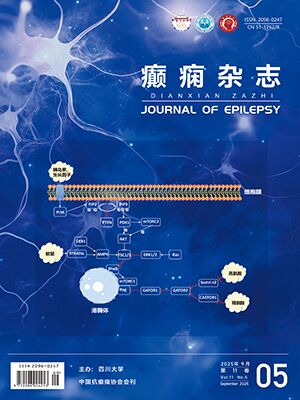| 1. |
Bektas G, Kipoglu O, Pembegul Yildiz E, et al. Epileptic spasm and other forms of epilepsy in presumed perinatal arterial ischemic stroke in Turkey after more than 10 years follow-up: A single centre study. Brain Dev, 2019, 41(8): 699-705.
|
| 2. |
Bamford J, Sandercock P, Dennis M, et al. Classification and natural history of clinically identifiable subtypes of cerebral infarction. Lancet, 1991, 337(8756): 1521-1526.
|
| 3. |
Thijs RD, Surges R, O'Brien TJ, et al. Epilepsy in adults. Lancet, 2019, 393(10172): 689-701.
|
| 4. |
Winkler AS, Leonardi M, Michael BD, et al. A WHO resolution on epilepsy and other neurological disorders. Lancet Neurol, 2021, 20(3): 171-172.
|
| 5. |
Benninger F, Holtkamp M. Epileptic seizures and epilepsy after a stroke: Incidence, prevention and treatment. Nervenarzt, 2017, 88(10): 1197-1207.
|
| 6. |
Rosenow F, Klein KM, Hamer HM. Non-invasive EEG evaluation in epilepsy diagnosis. Expert Rev Neurother, 2015, 15(4): 425-44.
|
| 7. |
Ding D, Zhou D, Sander JW, et al. Epilepsy in China: major progress in the past two decades. Lancet Neurol, 2021, 20(4): 316-326.
|
| 8. |
Scheffer IE, Berkovic S, Capovilla G, et al. ILAE classification of the epilepsies: position paper of the ILAE Commission for Classification and Terminology. Epilepsia, 2017, 58(4): 512-521.
|
| 9. |
Shorvon SD. The etiologic classification of epilepsy. Epilepsia, 2011, 52(6): 1052-1057.
|
| 10. |
Hanin A, Demeret S, Nguyen-Michel VH, et al. Continuous EEG monitoring in the follow-up of convulsive status epilepticus patients: A proposal and preliminary validation of an EEG-based seizure build-up score (EaSiBUSSEs). Neurophysiol Clin, 2021, 51(2): 101-110.
|
| 11. |
Menon B, Shorvon SD. Ischaemic stroke in adults and epilepsy. Epilepsy Res, 2009, 87(1): 1-11.
|
| 12. |
Rady A, Elfatatry A, Molokhia T, et al. Psychiatric comorbidities in patients with psychogenic nonepileptic seizures. Epilepsy Behav, 2021, 118: 107918.
|
| 13. |
Zamecnik J. Neuropathology of refractory epilepsy: the structural basis and mechanisms of epileptogenesis. Cesk Patol, 2012, 48(2): 76-82.
|
| 14. |
Prasad Hrishi A, Ruby Lionel K, Prathapadas U. Head rules over the heart: cardiac manifestations of cerebral disorders. Indian J Crit Care Med, 2019, 23(7): 329-335.
|
| 15. |
Fallah MS, Neupane B, Al Nassar M, et al. Interpreting the tests of focal cortical dysplasia for epilepsy surgery referral. Can J Neurol Sci, 2019, 46(5): 559-565.
|
| 16. |
李伟. 托吡酯治疗脑梗死后继发癫痫的效果及其对认知功能的影响. 国际精神病学杂志, 2019, 46(6): 1049-1051.
|
| 17. |
Holtkamp M, Beghi E, Benninger F, et al. European Stroke Organisation guidelines for the management of post-stroke seizures and epilepsy. Eur Stroke J, 2017, 2(2): 103-115.
|
| 18. |
Vivekananda U. Redefining the role of magnetoencephalography in refractory epilepsy. Seizure, 2020, 83: 70-75.
|
| 19. |
Hasan TF, Tatum W. Ambulatory EEG usefulness in epilepsy management. J Clin Neurophysiol, 2021, 38(2): 101-111.
|
| 20. |
Pyrzowski J, Le Douget J E, Fouad A, et al. Zero-crossing patterns reveal subtle epileptiform discharges in the scalp EEG. Sci Rep, 2021, 11(1): 4128.
|




